#morphology of the land
Photo

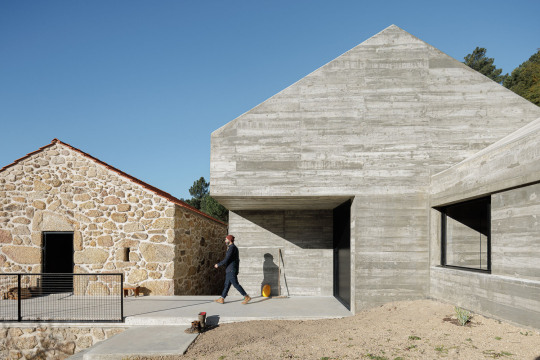
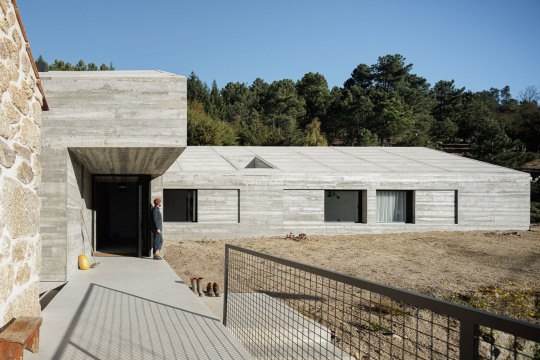





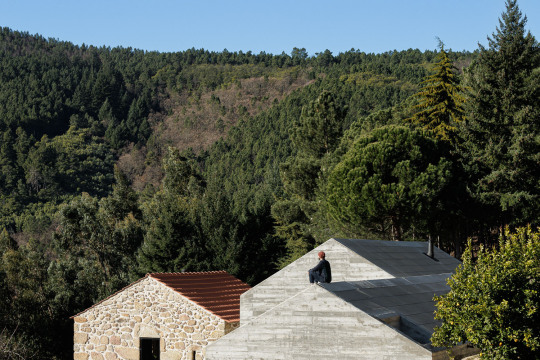

CASA NAMORA
By David Bilo & Filipe Pina
GONÇALO, PORTUGAL
Situated in a natural shelter of a valley at the foot of the Serra da Estrela, close to the parish of Gonçalo, in a place also known locally by the name of Mora, this agricultural property has approximately 18ha of area, and is surrounded by a dense pine tree forest. (...)
The name NaMora has a double meaning in Portuguese. It refers to the location of the project, where “Na Mora” would translate into “In Mora” (Mora being the place where the property lies), but “namora” in Portuguese means literally “flirt” or “date”. (...)
Inside, we sought the neutrality given by the simplicity and purity of the materials and by the illusion of the absence of detail. The idea of interiority translates into openings towards landscapes, frames, and courtyards strategically located.
Read more Archdaily
#Architecture#Gonçalo#PORTUGAL#Mora#agricultural property#pine tree forest#granite built#mid-twentieth century#morphology of the land#characterized by the existence of several terraces#new volumes of concrete were created and implanted in an existing terrace#farm#namora#CASA NAMORA#David Bilo#Filipe Pina#farm’s activities#neutrality given by the simplicity and purity of the materials#openings towards landscapes#frames and courtyards strategically located.
67 notes
·
View notes
Text
...
#god. do u ever just look out at a landscape and think: there are layers and layers of history buried under that strip of sidewalk#creatures lived and died and lived and died and changed morphologically like a meandering river. into the sea back onto land#diverging and convering evolution. building changes through ever branching phylogeny. its crazy. literally unfathomable#it's so painfully clear rn that my astrobiolological interests are entangled in understanding how life works. i want to know the tiny#details. i want to look at traits across different branches within a phylum and understand where differences creep in and what we can learn#about the past from the present. i want. i want. i want a project where it doesnt feel like im bleeding myself dry. i want to produce data#that doesnt feel like its a symptom of a disease. i want to cultivate knowledge out of love. not in an effort to drown myself. not out of#some frantic Compulsion. i want to look up at the stars and not feel the weight of all the time i have to keep moving when im never going#fast enough. exhausting. but here i am again. spiralling. bc i spent all day drawing not reading even tho i was learning thru audio all day#slacker. an excuse. irrational. im self aware! and yet that doesn't seem to make things easier. never relaxed. always guilty.#sigh... my dad txted me that he missed me today. theyre up on that lake brimming with fossils and dead fish and broken glass. i wish i was#there too. watching fireflies and crawling around for algae and lichens. anyway i digress... i should find a phd project i say for the#thousandth time. maybe ill have the motivation now. maybe ive recovered enough i say like i didnt spontaneous burst into hysterical tears#Friday morning for no descenable reason. maybe. maybe. youll never kno if u dont try#unrelated
29 notes
·
View notes
Text
India’s newest recorded snail named after Western Ghats
India’s newest recorded snail named after Western Ghats
The Haploptychius sahyadriensis is endemic to the Vishalgad Conservation Reserve in Maharashtra’s Kolhapur district
The Haploptychius sahyadriensis is endemic to the Vishalgad Conservation Reserve in Maharashtra’s Kolhapur district
The Western Ghats of Maharashtra have yielded a carnivorous land snail new to the world of science.
The Haploptychius sahyadriensis, recorded from the northern…

View On WordPress
#carnivorous land snail#Ghats#haploptychius morphology#haploptychius sahyadriensis#Indias#is snail found in india#is snail named after western ghats#maharashtra#maharashtra’s kolhapur#molluscan research snail#named#new snail discovered#new snail found in maharashtra#newest#recorded#sahyadri snail#snail#types of snails in india#vishalgad conservation reserve#Western#Western Ghats#western ghats new snail discovered#what’s the newly discovered snail named#where do land snails live
0 notes
Text
For this Wet Beast Wednesday I'll be going over one of my favorite animals: the horseshoe crab. The first thing you should know about horseshoe crabs is that they aren't crabs. They aren't even crustaceans. They're chelicerates, which makes them a close relative to spiders, scorpions, and sea spiders (not actually spiders). The name comes from the shape of the hard shell that covers most of the top of the body. There are 4 living species of horseshoe crab and many more are known from the fossil record, stretching back to the ordovician period around 480 million years ago. For comparison, that makes them about as old as the first jawed vertebrates if not older, and quite a bit older than the first land vertebrates. They are often called living fossils as they have changed relatively little in millions of years. Living fossil is a misleading term as the species alive today are not the same as those living alongside or before the dinosaurs and there are differences in morphology.
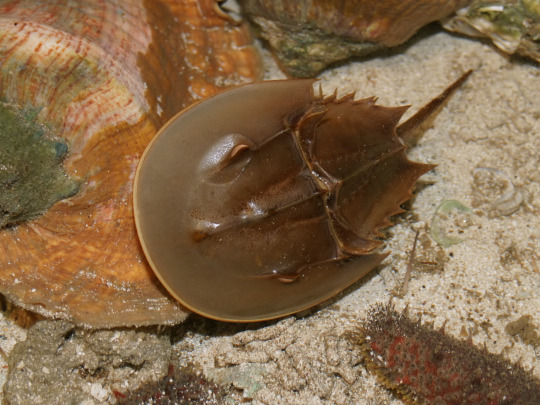
(image: a horseshoe crab from above)
While the most famous feature of the horseshoe crab it its large shell, there's a lot more going on on its underside. At the front of the body are the legs and mouth, which aren't all that distinct. Horseshoe crabs have 6 pairs of limbs. the front pair are known as chelicera, which are used to move food into the mouth. After that there are pedipalps, which most chelicerates use for food handling or for picking stuff up, but which horseshoe crabs use as another pair of legs. Males have modified pedipalps used for grabbing onto females when mating. Finally there are the true legs, the back pair of which is the one used mostly for pushing the animal forward. All legs except to back pair have claws that can be used for picking up food but are too weak to be used for defense. The mouth is located in the middle of the legs. The bases of the legs are rough and serve the same function as jaws, giving them the name gnathobases (gnatho means jaw). Imagine having your legs come out of your face and you have to walk around to chew and you know what it's like to be a horseshoe crab.
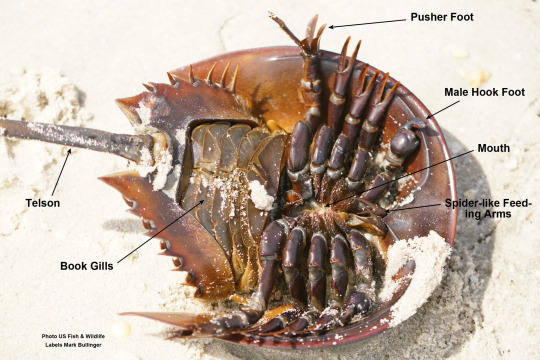
(image: a horseshoe crab with body parts labled)
After the legs comes the next body segment, which is home to the gills. Horseshoe crabs have book gills, which seem to be an evolutionary precursor to the book lungs seen in spiders and other arachnids. Horseshoe crabs have five pairs of these gills, each located on a flap that can move back and forward. Each flap is covered in over a hundred tiny membranes called lamellae that are used for gas exchange with the surrounding water. Horseshoe crabs keep their book gills moving rhythmically to keep water flowing over them. They can survive on land for several hours as long as their book gills stay wet. Because the gills can flap back and fourth, they are sometimes used to swim. This is only seen in young crabs as the adults are too heavy and they usually swim upside down.

(image: a horseshoe crab swimming upside down because I couldn't find a decent gif)
At the very back of the body is the telson or tail. Despite looking like a stingray tail and being related to a scorpion's stinger, the horseshoe crab's tail is harmless. They will raise it to try to scare off predators, but its main purpose seems to be flipping the crab over if it ends up on its back. The telson and legs can grow back slowly if removed. Like ofter chelicerates, horseshoe crabs have an exoskeleton and need to molt regularly, leaving behind their old shell. Females are larger than males, who will cling onto their shells during mating. Amusingly, some small horseshoe crabs will cling onto bigger ones just to get a free ride. They are predators whose diet consists mostly of small mollusks and worms. Horseshoe crabs prefer to live in shallow water with sandy sediment and are often found in bays and estuaries. Horseshoe crabs have 9 eyes. The most prominent are a pair of compound eyes that are easily visible on the shell. In addition, there are 3 pairs of simple eyes capable of seeing visible and ultraviolet light located behind the compound eyes, on the front of the shell, and on the underside by the legs. Another simple eye is the parietal eye located just behind the pair of simple eyes on the front of the shell. And if that isn't enough, they have a cluster of photosensitive cells on the tail. Horseshoe crab eyes have the largest rod and cone cells of any animal, over a hundred times the size of a human's. Despite this, they have very poor eyesight, mostly distinguishing between light and dark.
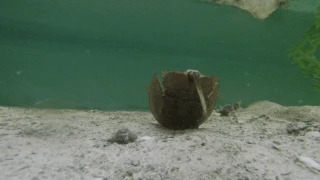
(gif: horseshoe crab righting itself)
There is one species of North American horseshoe crab and three Asian species. The one I am most familiar with and have had the chance to both see in the wild and handle is the North American Limulus polyphemus, which ranges from the Gulf of Mexico up along the Atlantic coast to Maine and southern Canada. Recent genetic studies have shown that there is very little mixing between a population around the Yucatan and the rest, possibly representing a subspecies or separate, related species. Some of the oldest DNA ever sequenced (about 2 million years old) was of L. polyphemus and was found off the coast of Greenland, suggesting their range was much larger in the past when the oceans were warmer. The northern population (north of southern Florida) Have a yearly mating season taking place in the spring during high tides and especially on the full and new moon. Females will crawl onto the beach to lay eggs in shallow burrows, which the males will then inseminate. Female can lay up to 80,000 eggs per year. It takes offspring about 9 years to become sexually mature and they can live an estimated 20-40 years. L. polyhemus has been extensively studied for topics including eyesight, circadian rhythms, and blood clotting.

(Image, mass horseshoe crab mating on a beach)
Horseshoe crabs have been studies for medical purposes regarding their blood. Their blood is bright blue and contains an important chemical called Limulus amebocyte lysate or Tachypleus ambeocyte lysate depending on whether it comes from the North American or Asian species. LAL/TAL reacts with a component in the cell membrane of gram-negative bacteria by clotting. This allows it to detect the presence of many species of bacteria, even dead ones. Tests using LAL allows scientists to detect contamination. The LAL test has been used in the US since 1977 and has been used for vaccine production, making horseshoe crabs responsible for saving millions of lives. To get the blood, companies will catch large amounts of horseshoe crabs and extract blood before returning them to the water where they will tell stories of being abducted by aliens to other, more skeptical crabs. The companies claim to have a mortality rate of 3-5%, but independent studies suggest the proper value should be 15-30%. A few artificial alternatives to LAL have been developed, but adoption of them has been slow and horseshoe crabs are still extensively caught and bled.
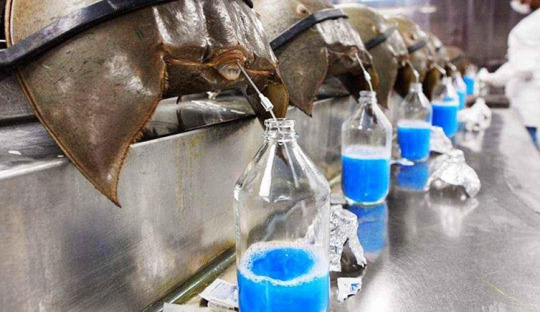
(image: horseshoe crab blood extraction)
The living species of horseshoe crab are all classified as vulnerable or endangered by the IUCN. Threats include habitat loss and fisheries. All species are fished for bait and the asian species and eggs are used for food. Catching for blood extraction also poses a threat. Horseshoe crabs are considered vital species in their environments and new protections should be enacted.
#wet beast wednesday#marine biology#biology#animals#ecology#zoology#horseshoe crab#animal facts#invertebrate#arthropod#critters
432 notes
·
View notes
Text
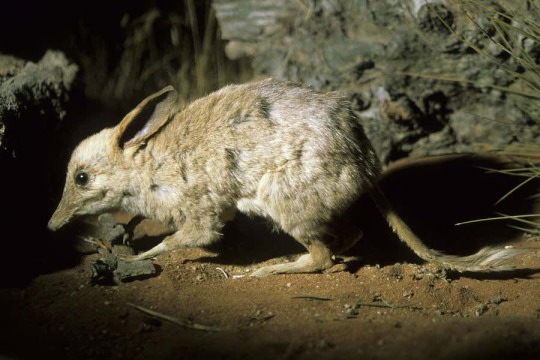
Chaeropus ecaudatus the Southern Pig–footed Bandicoot
Pig–footed bandicoots (genus Chaeropus) were so called because of their hooflike forefeet. They had relatively slender legs compared to other bandicoots, allowing them to move quickly through the landscape.
Although initially designated as a single species, Chaeropus yirratji was split from C. ecaudatus in 2019 on the basis of morphological differences. Both species became extinct by the 1950s due to habitat loss from land clearing for agriculture and predation from cats and foxes.
#southern pig–footed bandicoot#animals#australian animals#mammals#australian mammals#marsupials#australian marsupials#bandicoots#pig–footed bandicoot#s o: australidelphia#o: peramelemorphia#f: chaeropidae#g: chaeropus#sp: c. ecaudatus
32 notes
·
View notes
Note
What of vampire races? Like there's a primordial "source" that represent the abstract ideas of "being a vampire", and it splits into different forms?
There's a vampire infection that creates the dramatic, domineering, "superior race" type of vampires. There's a bloodline infection that creates the bestial, or chaotic vampires. There's a bloodline creating the hyper intelligent, 'prophetic" vampires that use science or mystics to gain knowledge. These "types" of vampire characters can be diversified as different bloodline infections, which creates the vampire's with different motivations to ....*be vampires*.
Why do some vampires want to continue progressing in their inecion till they reach a sort of evolution, while some just like to be constant beasts, while others are basically forced to feel like they're starving all the time which is why they hunt humanoids? Why are some vampires only able to sustain themselves from humanoid blood (even it only being humans sometimes), while others can mix blood and are shown to just like draining people of their blood? Why are some vampires more scientific, while others are using dark magic and behave more supernatural?
Maybe all the "visions" various vampire groups or lineages have of a vampiric "holy land" and Utopia, are memories of a "blood world". Where their specific vampire infection,is able to thrive the way it behaves. This "race" idea, isn't involving physical body morphology nor does it need to separate infected individuals of other races and "born vampires" (however that works in your story), from eachother. But its extending vampirism to a bigger conspiracy. Of an extraterrestrial infectious existence, that has their own "home worlds".
The cosmic history of those vampire bloodlines and "blood worlds" affecting eachother, or other races of beings can be to your advantage. It also provides vampires identity outside of an individual lineage of a specific species.
Friend, this is a d&d blog. If you want vampire the masquerade/requiem try the place down the block.
Jokes aside I find it funny that whenever you get an intersection of nerds and vampire groupies you end up with this idea of "superior bloodlines" that fundamentally separate vampires from what makes them narratively relevant.
I'll probably do a monsters reimagined about it later, but as undead vampires are only interesting when you consider how their vampirism reflects who they were in life, and how their nature as a bloodsucking monster relates to the themes of the story they're in.
I understand the desire to identify with monstrous outsiders, but when you distort the concept by piling in more and more powers and talking about how special and cool you they are, you dilute what makes vampires fun and just make them into goth-elves.
A vampire story that isn't in some way based in tragedy isn't really a vampire story at all, now is it?
47 notes
·
View notes
Text
Spectember D26: Break a biological record

Some hundreds of millions of years far into the future around 300 million years hence, after the formation of a big supercontinent, one that was not predicted to form, a lot of existing terrestrial and marine fauna look so alien compared to the animals that once man witnessed as the difference is as much as a human being would have to the first terrestrial tetrapod. Phylogenetically speaking many of those animals would be related to something like a crown, a snake, a varanid, a goby, a frog, a bat and so on but they are totally anatomically, morphologically and physiologically far from those, mammals and birds are a fraction of what they were, more mole or reptile like, varanids and frogs suffered of varied radiations and now they have been as much diverse as how dinosaurs and synapsids went through the Mesozoic and Cenozoic, and small fishes survived and radiated from freshwater species over and over from different mass extinctions, and just for matter of convergence they looked something like the modern species man saw, but they aren’t anatomically close to those.
In land mammals are just small and ectothermic creatures, in the ocean however one lineage managed to thrive as large swimmers, is not like any other group however, they have lost their forelimbs, their tails barely help them to swim and often depending of the species they have a rigid fluke or a seahorse-like prehensile tail, they managed to re-evolve some structure similarly to gills from a part of a nose cavity, a result of its proper ontogenic development as they did born not fully developed. These aren’t descendants of placentary mammals, but marsupials, a lineage that stood almost unchanged for many dozens of millions of years in the Americas and took a turn after the major calamities through the last 200 million years that drove their group to become reptile like, adopt peculiar adaptations for their lethargic metabolism and ended up in this stage, these aquatic animals were the last descendants of the opossums.
The Scorn Figoeq are a twisted form of the more seahorse-like herbivorous relatives that lives in the surfaces, living at depths of 4000 to 5000 meters under the surface is by far the deepest species of tetrapod that has ever lived, the deepest mammal to have diver so low under the ocean. It adopted the lifestyle of the already gone anglerfishes as well some other deep-water fishes, is among the last of an experimental lineage of the Figoeqs (Derivation of Figoeqqus or "shaped like horse") that tried to become pelagic planktonic feeders which ended up becoming extinct in the last 50 million years, remaining as a relic of that group. With 25 cm long, anything that could be considered mammal like only is exposed by looking at the embryo of this species as it starts with the basics of mammal anatomy, but reaching adulthood they resemble a mix of a jelly and a bizarre abyssal fish, with their short body, large head with a deep gelatinous cover that protects part of its head and eyes that now grow inside the flesh, with long dorsal spines that helps it to stabilize while swimming, their long hind flippers that look more like ray fins, and the tail that has grow a fluke to push it slowly across the darkness of the abyss.
57 notes
·
View notes
Note
what do you think of people making their own tonitrui characters? I love your work, the faces are super nice to look at, teeth and all
i dont mind at all! tonitrui are very close to my heart as theyre by far my oldest original species/headworld, but ive yet to actually do anything with them and dont really have much motivation to do so. the tonitrui i primarily draw are ocs from another story entirely which is fundamentally a human story, but i vastly prefer drawing the weird goats over humans.
i suppose this is also as good a time as any to "officially" describe tonitrui.
there are some rules that come with them since they are designed to inhabit a specific setting and play a certain role within their world. but at the same time i dont really care much, and have always enjoyed seeing other peoples takes on the species in the past, even if they break some rules
theyre a primarily carnivorous species which is on average 2 feet taller than the average human, ranging between 6-8 feet in height. this great size, along with their diet has forced the southern portion of their population to rely heavily upon fishing and animal agriculture to support a substantial population/military, and to eschew many of the superfluous aspects of their historical culture. as a result tonitrui are generally very utilitarian, what few festivals and art they have is generally related to bloodsports and ritual combat. they are a race strongly influenced by the pressures surrounding them, this primarily being other equally sapient but different races which they compete with for land and resources. unlike other races they have no allies, and either conquer or destroy their foes, however their colonial and expansionist tendencies can't keep up with a dwindling population, subseptibility to disease, civil war, corruption, and general hubris.
as for religion, monarchist tonitrui have a historical theistic framework that they have mostly abandoned, for good reason. many generations prior (to the general timeline) their corresponding creator god (each race was created by an individual god, the many civilizations acting as a living chess game, this is not known to the mortals below, they dont know they exist to better the social reputation of another entity entirely) walked among them as a god king. this was of course seen as blatant foul play by the fellow players so they locked it in that mortal form, and being confronted by mortality drove it mad. the specifics of whether or not the god king killed itself, or was murdered by his own subjects is widely disputed, but the impact of that betrayal has turned much of the kingdom off theism entirely. luck and chance are the spirits that tonitrui pray to now, even if ever since, their civilization has begun to crumble from within and without. their every enterprise fails, their wars of conquest fold back in on their own territory, plague strikes them endlessly.
the northern population is technically part of the southern kingdom, however their way of life (more nomadic, hunter-gatherer based) has typically set them apart. there is still free trade and travel between them, and they still pay taxes and obey military conscription, however there is increasing resistance to these, and governmental authority weakens as the northern population becomes more preoccupied with their own struggles.
in terms of morphology, tonitrui have two sets of flat incisors much like a horse, prominent canines which can occassionally stick out between their lips, and canine-like carnassials and molars. their faces are rather stiff for the most part and they primarily emote through their eyes, the corners of their mouths, their ears, and the tilt and posture of their big heads. they can just barely lift their top lip, and the muscles that control snarling and snout wrinkling in mammals are quite reduced or nonexistent in tonitrui, they compensate for this by opening their jaws very wide as an aggressive signal, and sometimes slamming their lower jaw shut to clack their teeth, but the latter is super rude, its basically a death threat.
their horns are primarily for display purposes, with a huge amount of variety that distinguishes individuals and family lines. generally their horns are relatively small when compared to those of existing ungulates, and particularly large horns are seen as ungainly and may be trimmed down in order to keep appearances and prevent them from being used against them in combat. young tonitrui naturally have the desire to ram their nubby horns against things, much to their parents exasperation, and everything breakable has to be well hidden in the household. though this is considered a childish and unrefined form of combat by the mainstream population, some more isolated villages still hold contests of strength where one must push their opponent past a line with only their horns.
their feet have no distinct nails and the toes are progressively keratinized until they are quite hard at the very tip, useful for gripping a variety of surfaces. in appearance they sort of resemble a blend of claws and hooves, clooves if you will.
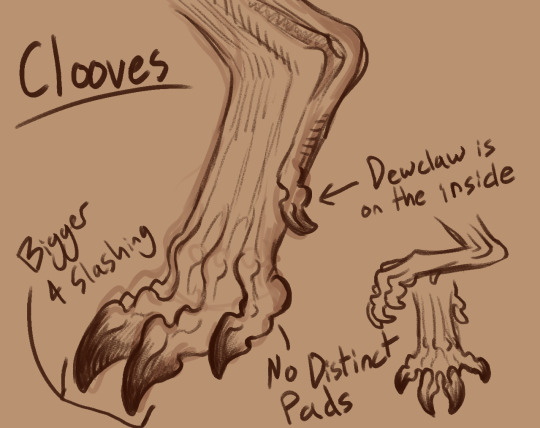
tonitrui are generally covered in a short, peach fuzz fur that thickens around their head, neck and down the length of their spines, and this is generally accompanied by a dorsal stripe of darker fur and lighter patterning on their chest and bellies. their patterning is usually very basic, darkened extremities tend to be more common in northern populations, and piebaldism pops up a lot in the south. their colors range from white to gray to black, to tan to gold to brown. northern tonitrui generally have shorter, broader snouts, smaller ears, and a mane that covers the entire circumference of their neck rather than just the top ridge. however the two populations have mixed to the point that these traits can be found across their entire range.
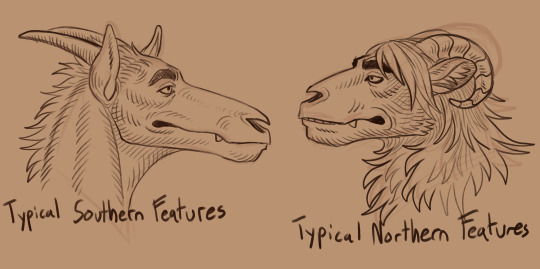
tonitrui always get their tails docked as infants, and if it isnt done by their families for some reason, individuals will often have the procedure done later in life to prevent the associated social rejection. tails are considered an unnecessary extravagance and liability, especially given how long and thin they are by nature. in a duel or battle they are easily broken, or used to pull an enemy off balance. back during the formation of their kingdom and the conquering of atomized clans into one entity, soldiers would often cut the tails off the locals and whip them with them as punishment for crimes real and imagined, so docking became a practice of integration, and preemptively avoided such humiliation. and whatever practice is compulsory in the military quickly becomes unofficially expected in the rest of the population.
in terms of gender norms, tonitrui arent beholden to anything resembling the human concept. they arent even mammals, and while they have the two typical sexes, they have far less sexual dimorphism than humans, and both sexes have the capacity to feed their young via specialized glands in their throats. females are on average smaller and slighter than males, but this remains the primary difference, and as a result social norms and gender roles are far reduced in tonitrui culture. personal wealth does tend to accumulate with the matriarch of a family because they are more likely not to die in battle. historically females have never been conscripted in the military, although there was no rule against them signing up until relatively recently, due to the powers that be realizing that males are far less crucial to the longevity of a society, especially one with a dwindling population.
39 notes
·
View notes
Note
followed you because when you reblogged my bad communication post i loved your url !! do u have any nudibranch propaganda to share?
Hell yea i do!! This got a little long :)
These funky little dudes have the coolest morphology, something theyre well known for. They can be pretty tiny (0.4 cm) or surprisingly large (60 cm) and generally live in the tropics, though there are certainly a wide variety that live in cooler ocean water as well. Some of the more well known species are very eye catching, like the Jorunna Parva (Bunny slug) or Glaucus Atlanticus


Some of them look like funky leaves and some of them look like slugs we see on the surface too! (Did you know licking banana slugs that you find on land makes your tongue go numb? 10/10 not recommended but i was a dumb kid)
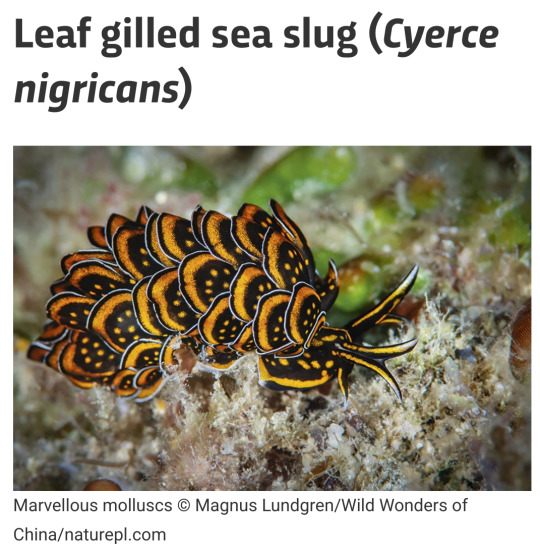
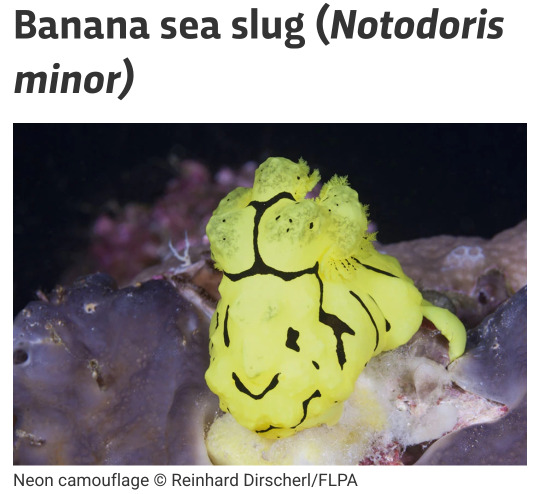
They also come in a goth or clown variant for those that are looking to fit a certain aesthetic :)

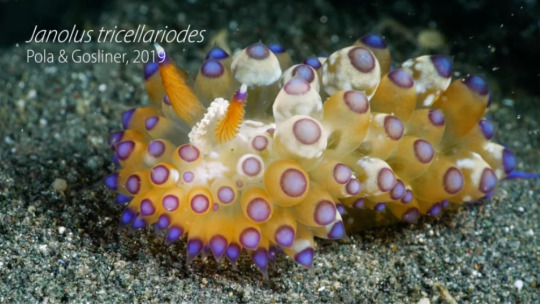
Theres two kinds of nudibranchs. Dorids, which breathe from a central plume of gills above their ass, and Aeolids, which breathe from a collection of spiky protrusions called cerata. There are a couple more distinguishing features relating to their digestive tracts and mantles (or lack thereof), but this is the easiest way to tell them apart in my opinion!


Theyre also carnivorous! These guys will eat a wide variety of stuff, including sponges, coral, barnacles, anemones, and even other nudibranchs and their eggs.
There are a couple species that have some pretty cool diets, like the Glaucus Atlantica, which preys on the portugese man of war and other siphonophores. It can eat the man of war whole if theyre small enough, but will also just eat the tentacles if theyre too big. Glaucus will then push the stinging nematocysts (the bits that hurt) from its insides to its outsides and use them as self defence!
There are also sea slugs, like the Costasiella Kuroshimae (technically not a nudibranch yada yada yada) that eat algae they then use to photosynthesize!
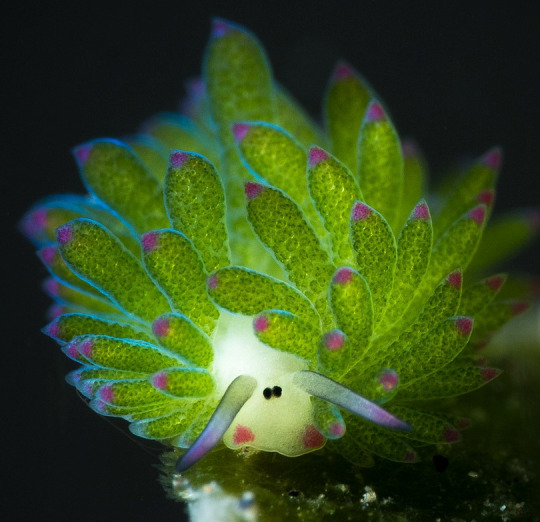
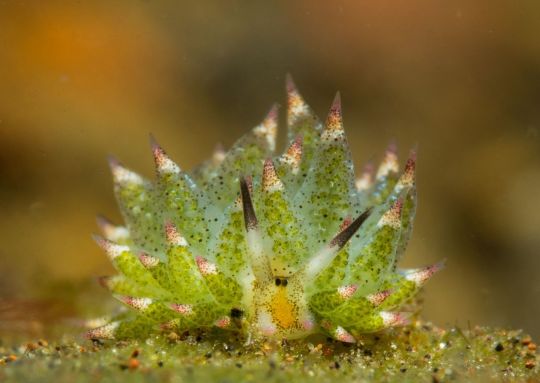
These funky little creatures are also hermaphroditic! Like a lot of animals, they use mating dances to attract a partner. Thats not whats cool about their reproduction though. When the time comes to lay their eggs, they do so in the coolest ribbon-like structures.
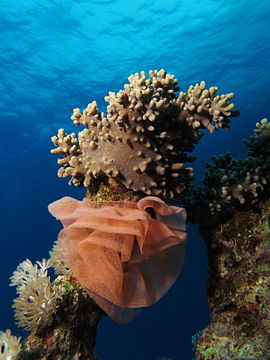
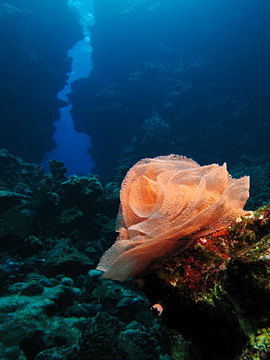
Mostly though, i just love how different all these little guys are. Personally, my fav nudi is from the ocean near where i live!

Anyways, that was rlly long. thanks if u ended up reading and defs look into these little weirdos on ur own!! (references? idk her :P but actually i dont remember where i learned most of this, though some supplemental info and pics w out credits from wikipedia!)
#syb rambles#nudibranch#sea slugs#marine biology#these r my specialest most favorite animals#also they cant see for shit#as someone who also sucks at seeing things#i love them so so so much#chatter
107 notes
·
View notes
Text
Slig

Concept art by Steven Olds, © Oddworld Inhabitants. Accessed at the Oddworld Wiki here
[Sponsored by @martyslittleusedblog. They're been trying to get me interested in monsters from platforming games for a while, and this is what hooked me. Partially because I remember Oddworld and Abe's Odyssee for the PS1. My cousin was the one with the Playstation, and he didn't like the game, but I remember poring over the manual and delighting in the concepts and the art. A dystopian game where a low level employee at a meat packing plant fights a corporate empire and becomes a reluctant Chosen One? Yes please!
The sligs are the main grunt force of said corporate empire, the Magog Cartel. Imagine if koopas carried shotguns. Apparently a slig slave revolt is a plot point in one of the later games. Good for them. If you're super worried about game balance, this is another monster, like the watchuka, that has a lot of treasure for its CR because guns and other ranged weapons are very expensive in Pathfinder 1e.]
Slig
CR 4 NE Aberration
This green skinned creature has a squid-like head with five finger-like feelers surrounding its mouth. It has large muscular arms and metal legs. It wears a set of red-tinted goggles and carries a large gun.
Sligs are eusocial mollusk-like creatures native to the swamps of the planet Mudos. They are most commonly found elsewhere as grunts, soldiers and assassins, as their queens have gladly sold the entire species to the Magog Cartel, a massive industrial empire. In exchange for unquestioning service, the Cartel provides sligs with greater mobility. A slig is born with strong forelimbs and stunted hind limbs, perfectly serviceable for pulling themselves between bodies of water, but good for little else. A slig in slig pants, however, can walk, jump and use its arms for carrying weapons; typically guns. Sligs love guns. Most sligs also wear goggles on a regular basis, both to protect their eyes (they are naturally nocturnal and live in foggy swamps) and because higher ups in the Magog Cartel find their beady eyes aesthetically displeasing.
Few sligs are very bright, but most of them are very cruel. Unlike many other eusocial sapient species but more similar to bumblebees and paper wasps, there is frequent infighting among sligs as they jockey for rank. The Cartel has managed to channel that into organized contests like kill counts, employee of the month bonuses and frequent games. Another privilege is the use of names—all sligs have a name, but using it publicly instead of a number and rank has to be earned by service to the Cartel. Sligs off duty are often found playing card games or sports, and those not playing are usually betting their spare income on such matches.
A slig stands about five feet tall. They are short lived, and considered adults by 2 years and ancient by 20.
Variant Sligs
Sligs are naturally morphologically plastic, as they respond quickly to changes in hormone levels. In addition, different sligs may have different abilities due to different equipment and cybernetics bestowed on them by the Magog Cartel. For example, Big Bro sligs are Large sligs who have to be equipped with special four-legged slig pants to support their weight, and are often given automatic weapons. Some sligs are given flying harnesses instead of pants—they have a fly speed of 40 feet (perfect), but no land speed. Other sligs, especially with class levels, may be equipped with heavier armor, flamethrowers, or rocket launchers.
Slig CR 4
XP 1,200
NE Medium aberration (aquatic)
Init +2; Senses darkvision 60 ft., Perception +6
Defense
AC 17, touch 12, flat-footed 15(+2 Dex, +3 natural, +2 armor)
hp 47 (5d8+25)
Fort +5, Ref +3, Will +4
Weakness light blindness
Offense
Speed 30 ft., swim 20 ft.
Melee 2 slams +4 (1d6+1) or heavy mace +4 (1d8+1)
Ranged masterwork shotgun +6 (1d8)
Statistics
Str 13, Dex 15, Con 18, Int 8, Wis 10, Cha 11
Base Atk +3; CMB +5; CMD 16
Feats Deadly Aim, Exotic Weapon Proficiency (firearms) (B), Gunsmithing (B), Point Blank Shot, Toughness
Skills Acrobatics +8 (+12 when jumping), Craft (firearms) +2, Knowledge (engineering) +5, Perception +6, Survival +6
Languages Common, Slig
SQ amphibious, slig pants, uplifted
Ecology
Environment any land
Organization solitary, pair, squad (3-8), troop (9-24) or army (25-100)
Treasure standard (veemod goggles with brown veemod, 2 batteries, masterwork shotgun with 10 pellet cartridges and 10 slug cartridges, heavy mace, other treasure)
Special Abilities
Slig Pants (Ex) Most sligs encountered wear slig pants, a set of robotic lower legs designed for a slig to sit in and control. These pants grant the slig a 30 foot land speed, a +2 armor bonus to AC (that doesn’t stack with worn armor) and a +4 racial bonus to Acrobatics checks. A slig without its pants on has a land speed of only 5 feet, and cannot use manufactured weapons as it needs its hands to move. A slig without pants is a CR 3 creature. A slig’s pants are destroyed when the creature is slain (and cannot be worn by anything besides a slig regardless).
Uplifted (Ex) A slig gains Exotic Weapon Proficiency (firearms) and Gunsmithing as bonus feats.
90 notes
·
View notes
Photo


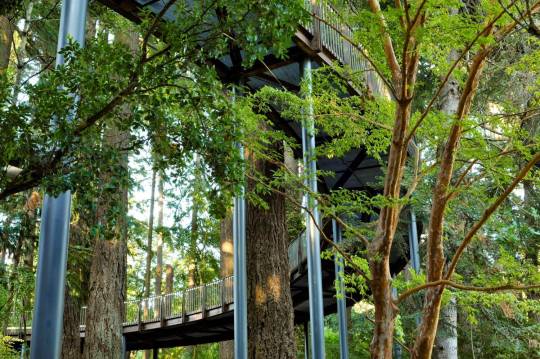
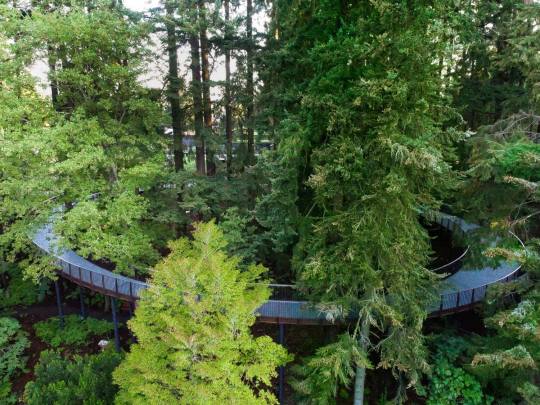






Leach Botanical Garden, Portland, Oregon,
Land Morphology & Olson Kundig Architects
#art#design#landscaping#gardens#landscaping architecture#botanical garden#oregon#portland#leach botanical garden#land morphologie#olson kundig#green#fireside terrace#walk#tree walk
110 notes
·
View notes
Text
Writing Patterns (Tag Game)
Rules: list the first line of your last 10 (posted) fics and see if there's a pattern!
Thanks for the tag @goddammitjim ! I can't remember when I've last done something like this but hopefully I've created at least 10 new fics since then
"Ben silently watches Cody read." - Feast, my 2nd edwardian wlw codywan
"Cody’s hands are sweating inside his gloves." - Tending Towards Silence, a sombre cody retrospective
" . . . Thus [the Clone Soldier Facility Language] is arguably a pidgin, despite its novel morphology and phonology formulated under isolated conditions." - Abstand and Ausbau, an in-universe media fic for an unelaborated xmen au codywan
"[Typed blue header text: Writing Module.] [In pencil:] Today me and fives and rRex got to punch the big bags [Evidence 03.53.11] to see if we are strong now and I moved it 3 inchs!" - Tunneling, the sequel-ish to Abstand and Ausbau xmen au with a confusing piece of annotated in-universe media at the beginning that tripped me up while doing this tag game
"Ovens these days are such untrustworthy things." - Milk, Sugar, Cocoa, a The Old Guard codywan where they make brownies
"One day, a swan-maiden lands on an imprisoned isle." - Monday: Fairy Tale/Mythology, a wlw codywan au for @order63
"Excerpt from elle.com/culture/celebrities, Aug, 2022. The perfect phrase to describe Cody Fett and Obi-Wan Kenobi as a couple is ‘stage presence’." - Tuesday: Arts Professions, a wlw codywan au for Order 63 with stage actress obi-wan and glam rocker cody that also has in-universe media why do I do this to myself
"Cody understands why they call it a snowstorm, when your TV is full of white noise, an endless, blurry white and grey." - Wednesday: Alt Prompt Snowstorm, a wlw codywan au for Order 63, there's a video store
"They’ve been sharing the lodge for the past couple days, a perfect example of genial skiing sports relations." - Thursday: Sports, a wlw codywan au for Order 63, with wintersports
"In Florence, they share a suite that looks out over the high, sharp tower of the Santa Croce Basilica, but the view that truly arrests Ben is the one from the top staircase window." - Friday: Historical, a wlw codywan au for Order 63, and we're back where this list started with edwardian ladies!
Patterns? I think my first lines have gotten shorter over the years maybe, and there's a lot of in-universe media excerpts cluttering up the place lol. I like finding characters mid-way through actions just as much as I like describing a setting, apparently!
I'm not sure who's been tagged, so I'll go with @cabezadeperro and @lttrsfrmlnrrgby and @elwenyere and @adiduck ? I'm sure I'm crossing over into lore's tagged people now so mwah goodnight <3
17 notes
·
View notes
Text
Wet Beast Wednesday: beavers
I love rodents; they're my favorite mammals. So today I'm combining rodents with the usual Wet Beast Wednesday to talk about beavers. These rodents are not only amphibious, they're engineers that play a major role in their ecosystems. Let's find out why you should appreciate beavers.

(Image ID: a beaver standing on dirt. It is a rotund, furry mammal with a large, blunt head. Its legs and eyes are small. Its tail is wide, flat, and hairless. It is wet. End ID)
There are two species of beaver: the North American beaver Castor canadensis and Eurasian beaver Castor fiber. The two species are so similar to each other in morphology and behavior that it took genetic testing to confirm that they are distinct species. Each species is divided into many subspecies, with a classified 25 for the North American beaver and 9 for the Eurasian beaver. Beavers are the second largest living rodents after the capybara. Adults have a body length of 80-120 cm (31-47 in), tail length of 25-50 cm (9.8-19.7 in) and usually weigh between 11 and 30 kg (24-66 lbs) but can reach up to 50 kg (110 lbs). Beavers are semiaquatic and have multiple adaptations for living in the water. The hind legs have webbed toes and are used to provide propulsion while swimming. The wide, flat, paddle-like tail is used as a rudder. Beaver fur is very thick, with 12,000 to 23,000 hairs per square centimeter and grows in multiple layers. The hair keeps the beaver warm and provides buoyancy while being thick enough to act as armor, protecting the beaver from predators. Beavers can hold their breath for up to 15 minutes, but most dives are shorter than that. While underwater, the beaver's heart rate is halved and blood is redirected to the brain and away from the extremities. The ears and nostrils can close underwater and the mouth can form a watertight seal. Being highly adapted for swimming, beavers are somewhat clumsy on land, but they can still move fast if needed. The front feet are very dextrous and can carry objects. Beavers can stand and move on their hind legs while holding things with their front feet. The tail helps provide stability while standing up. Like other rodents, beavers have an upper and lower pair of incisors that grow for their entire lives. The teeth need to be worn down by gnawing on objects and a beaver that can't gnaw can suffer from health problems as their incisors grow too big. Beaver teeth are coated with a layer of enamel that contains iron compounds, giving the incisors a characteristic orange color. The teeth grow outside the mouth and the beaver can close its lips while moving the teeth, letting it chew or pick thing up with its teeth underwater without getting water in its mouth. Unlike other rodents and pretty much every mammal, the beaver's excretory and reproductive tracts are merged into a single hole called the cloaca. Cloacas are common in reptiles, amphibians, etc, but having separate holes is a kay mammal trait. Beavers must have evolved back into having a cloaca. One hypothesis for why is that having a single hole reduced the surface area that can be exposed to the water, reducing the chance of infection. Males have a penis that extends from the cloaca when in use. Because of this, male and female beavers are virtually indistinguishable by sight if the penis is retracted. Staying downstairs, beavers have two sets of scent glands, anal glands and castor sacs. Both are used to produce scent chemicals that are used by beavers to mark their territory and identify each other. The anal glands also produce an oily substances that beaver groom into their fur to help waterproof it. The castor sacs produce a substance called castoreum and are attached to the urethra. Ancient people often thought that the castor sacs were testicles and that female beavers were actually hermaphrodites.
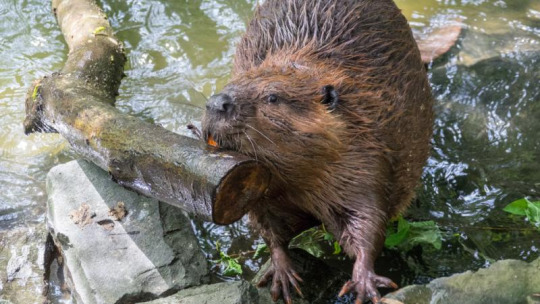
(Image ID: a beaver seen from the front on some rocks by the water's edge. It is dragging a long log in its mouth. Its top incisors are visible and orange. End ID)
The North American beaver is found in most of Canada and the United States, as well as northern Mexico while the Eurasian beaver's natural range has been considerably reduced from what it once was. They now live in portions of western, central, and eastern Europe, west Russia, and Scandinavia, with isolated populations in Mongolia and northwest China. Beavers live in freshwater (and occasionally brackish water) streams and lakes. They are nocturnal and crepuscular, active most commonly between dusk and dawn. Beavers are generalist herbivores, eating a variety of leaves, stems, shoots, roots, and bark. They prefer herby food in summer and woody food in winter. Beavers form stores of food underwater for the winter. Their digestive systems have an enlarged portion of the intestine called a caecum that helps digest the cellulose form all the plants and wood they eat. Their feces has been reported to have sawdust in it. Beavers are territorial and mark their territory with smell using secretions from their anal and castor glands that are placed onto piles of rock and mud they build. beavers defend their territories fiercely and will get into fights with others trying to move into their territory. Beavers who live in neighboring territories will gradually grow less aggressive toward each other and they become used to each other's scent. This is called the dear enemy effect and is seen in other territorial species. Beavers communicate using a variety of noises including whines and growls. A common behavior is slapping the tail against the surface of the water, which is used to alert other beavers to danger.
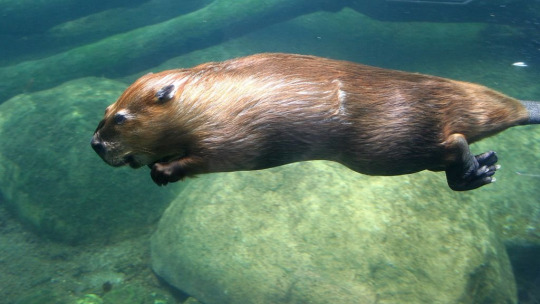
(Image ID: a beaver swimming underwater. Its body is strengthened out and streamlines. Its front legs are tucked under its chin. The hind legs are being used for swimming. The tail is out of frame. There are rocks and logs in the background. End ID)
Beavers require deep and still water to build their homes, but they aren't satisfied just looking for lakes to live in. No, these little entrepreneurs will make the conditions they need by damming streams. I will devote a whole section below to beaver damming and its impacts on the environment. Aside from dams, beavers also build lodges, which are their homes. Building these structures requires material and beavers use wood, mud, and rocks. To get the wood, they use their incisors and powerful teeth to chew through trees and branches. Famously, a beaver can take down a large tree in under a day. Lodges take a while to build, and until it is ready, beavers live in simple burrows on the water's edge. There are two types of lodges: bank lodges and open-water lodges. Bank lodges are burrows along the water's edge covered in sticks and are more common with Eurasian beavers. The more famous open-water lodges are built away from the shore. A pile of sticks forms a platform that is covered with a dome. The dome reaches above the water and is made of sticks and rocks held together with mud. Inside the dome but above the water is an open cavity filled with air. This is called the living space and is (as the name suggests) where the beavers live. The only above-water opening in the living space is an air hole built in the very top. The other entrances are underwater, meaning that beavers can only enter and leave by swimming. This provides good protection from predators, most of whom wouldn't be able to swim into the living space, as wells as insulation to keep the living space warm in winter. Beavers live in familial groups usually consisting of a pair of parents and up to eight children. Family members use the scent of their anal glands to identify each other and will body through grooming each other and play-fighting. The parents are monogamous, but will seek out new mates if they lose theirs. Mating occurs in late December to mid January when the female goes into heat. Up to four pups are born three to four months later. Beavers are born furry and with open eyes and can digest solid food after a week, but usually nurse for up to three months. Beaver milk is more fatty than the milk of other rodents. Beaver offspring will stay with their parents for two years before becoming independent and a family can have two generations of offspring at a time. The largest families need to build multiple lodges. The offspring, called kits, will stay in the lodge for their first one to two months and will start assisting the family with construction of dams and lodges at a year old. They reach sexual maturity between one and three years of age and can live for up to ten years in the wild. Beavers that become independent will travel away from their parent's pond to find a new stream or pond to settle in. This is the time most beavers meet their future mates and the pair will travel together in search of their new home. Beavers will stay in the same territory unless poor conditions force them to leave and find a new home.

(Image ID: A beaver in the Minnesota Zoo with four kits. They are in an artifical lodge with stone walls and star and sticks on the ground. The kits are miniature versions of the adult. End ID.)

(Image ID: an artistic depiction of a beaver lodge with a cutaway to show the interior. It is a large pile of branches with a chamber inside partly submerged in the water. The chamber is connected to the outside by two tunnels the open underwater. There are two adult beavers outside the lodge and three juveniles inside. End ID. Source)
The most famous feature of beaver behavior is their dams. By damming streams, beavers create the large and still ponds they need to build their dams. Beavers that live in pre-existing ponds or lakes that are deep enough for their lodge entrances to be underwater don't need to build dams. To start, thy will dig canals to reduce the flow of the stream, then drive large logs and branches into the mud of the stream bottom to form a base. The dam is then filled in with rocks, branches, shrubs, mud, and anything else the beaver can get its paws on. Beavers can pull or carry objects up to their weight and will build canals and use mud slicks to pull larger logs. Dam complexes can cover acres of territory and the canals beavers dig dig to divert water and help move logs around can be over half a kilometer (1,600 ft) long. The largest dam in the world is in Alberta, Canada's Wood Buffalo National Park and is 775 meters (2,543 ft) long and growing. It was formed of different dams that were combined. Beavers are one of the best examples of ecosystem engineers, species that modify their habitats. They are also a keystone species that are vital in wetland areas of their native range. Dams expand wetlands and reshape the stream environment in ways that typically benefit the local ecosystem. There are some negative impact of beaver dams, including impeding fish migration, increasing silt upstream of the dam, low oxygen levels in the created ponds, and harming species that require fast flowing water. However, the positive impacts of the dams are many and varied. The dams create new ponds that provide habitat for many species that require deeper or slower water, including many aquatic insect larvae, worms, and mussels. These ponds are also ideal spawning locations for many fish and amphibian species, especially salmon and trout that can leap over the dams. Indeed, beaver dams are a huge boon to salmon spawning. The ponds also raise the local water tables and help prevent drought. The areas in and around ponds see a large increase in plant species diversity that encourages local grazing animals and migratory species to visit. Because the areas around beaver ponds are so wet, they act as natural fire breaks, helping mitigate the damage from fires. The dams also help prevent floods downstream by slowing the amount of water that passes, thus helping prevent erosion. The dams act like sieves, filtering out silt, debris, excess nitrogen, and pesticides and other chemicals that get into the water. Bacteria living in the dams break down cellulose in plant matter and release nitrogen gas into the atmosphere. On the downside, beavers have been extending their range north as the arctic warms and their ponds are melting permafrost, which releases methane into the atmosphere.

(Image ID: a beaver in a forest environment gnawing a tree. The tree trunk is slightly thicker around than the beaver. The Beaver is chewing at one side of the tree while the other side is already chewed, resulting in an hourglass shape. End ID)

(Image ID: two beavers sitting on top of their dam and working on building it. One beaver is gnawing on a log while the other one is carrying a bundle of roots in its mouth. End ID)

(Image ID: a beaver dam seen from above. The dam is a large pile of sticks, longs, rocks, and mud that stretches across a stream. The water level on one side of the dam is significantly higher than on the other side. End ID.)
Both species of beaver as currently classified as Least Concern by the IUCN, meaning they are not at risk of extinction. This was not always the case. Beavers have historically been heavily trapped for their meat, fur, and castoreum. The castoreum was used in many forms of medicine. Nowadays it isn't used anymore except in homeopathy and other forms of quackery. The fur trade vastly reduced beaver populations and it was only due to new laws and conservation efforts that the two species were saved from extinction. Since then conservation efforts have largely revolved around trapping beavers and reintroducing them to new areas. Probably the most famous example of this is the 1948 beaver drop, when the Idaho Department of Fish and Game dropped beavers in crates from planes, where they parachuted to the ground and were released. Despite how silly this sounds, it had a much higher survival rate than other relocation methods. Only one of the 76 beavers died due to forcing its way out of the crate during the drop and falling to its death. Beavers can damage infrastructure by damming streams near human activity and can damage trees people want to keep alive. There are ways of mitigating this. Pipes can be used to keep the water levels of the ponds from getting too high and fences or other deterrents around trees keep the beavers from cutting them down. If the beavers are causing too much of a problem, trapping and relocating them can help. On the other hand, sometimes environmental managers trying to attract beavers will make artificial beaver dams to try to entice beavers to adopt a stream. This is sometimes done in streams with too much erosion or water that flows too fast for beavers to settle. The artificial dams start the work and set things up for beavers either relocated to the stream or that pass by and settle down. Beavers are used as symbols of hard work, industry, and families. The beaver is the national animal of Canada. If Canada appreciates the beaver, shouldn't you too?
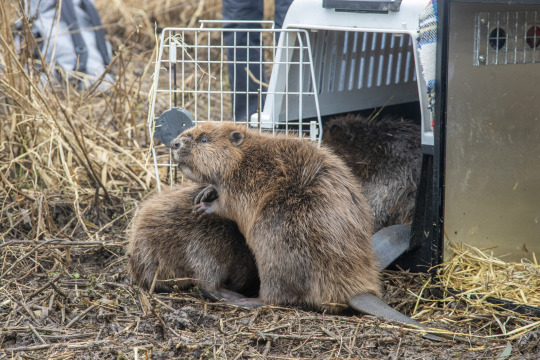
(Image ID: a group of three beavers being released from a crate. End ID)
youtube
(Video ID: archive footage of the 1948 beaver drop. End ID)
#wet beast wednesday#beaver#rodent#mammal#beaver dam#beaver lodge#biology#zoology#ecology#freshwater ecology#animal facts#long post#educational#image described#Youtube
49 notes
·
View notes
Text
This is it. The book that got me into Hymenoptera. I remember discovering this book in my living room and brought it to high school. I was in art class, I forget what was going on, but I was quite bored, so I started flipping through the pages. At the time, I had started becoming interested in Nearctic Vespines. Flipped through Diptera, Lepidoptera, Coleoptera, but once I landed into the Hymenoptera section, I grinded to a halt. I was so in awe and amazed by the diversity and morphology of these beasts, that I couldn't get my eyes off the pages! I've never looked back since. So many awesome memories with this book that paved the path to my specialization in the huge and vast world of entomology. 😁 I didn't choose Hymenoptera, it chose me. 🥹
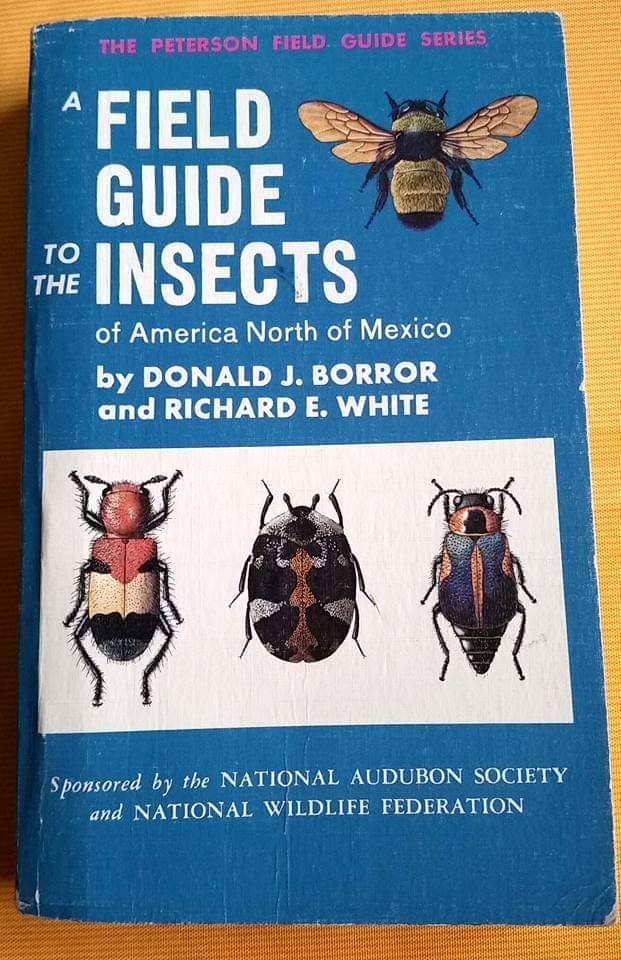

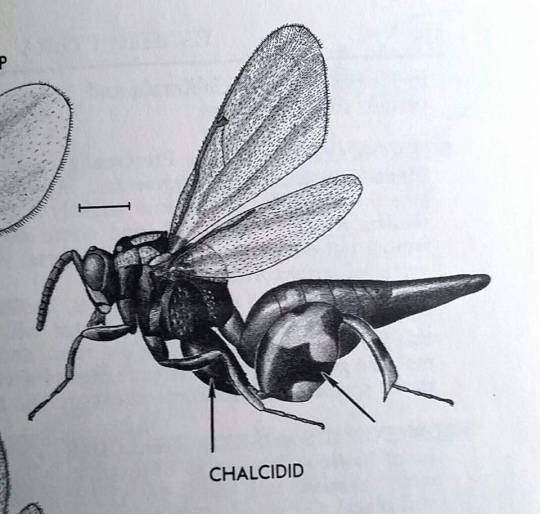
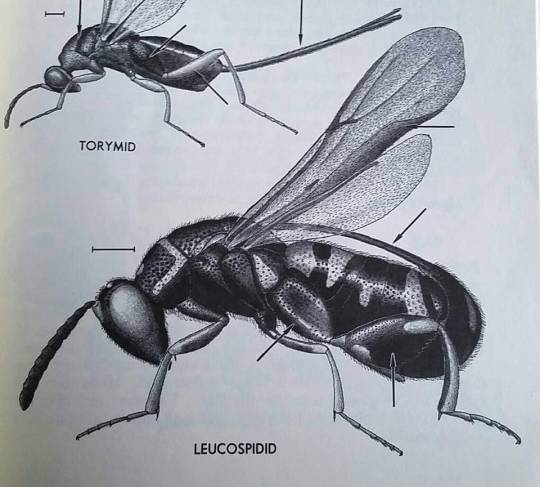
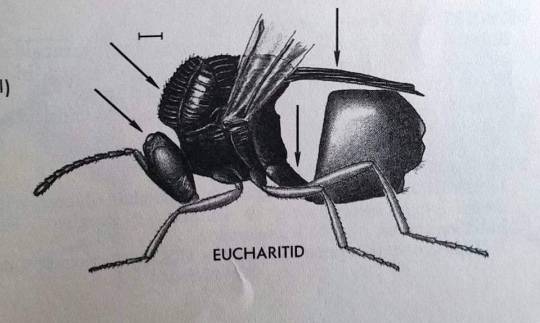

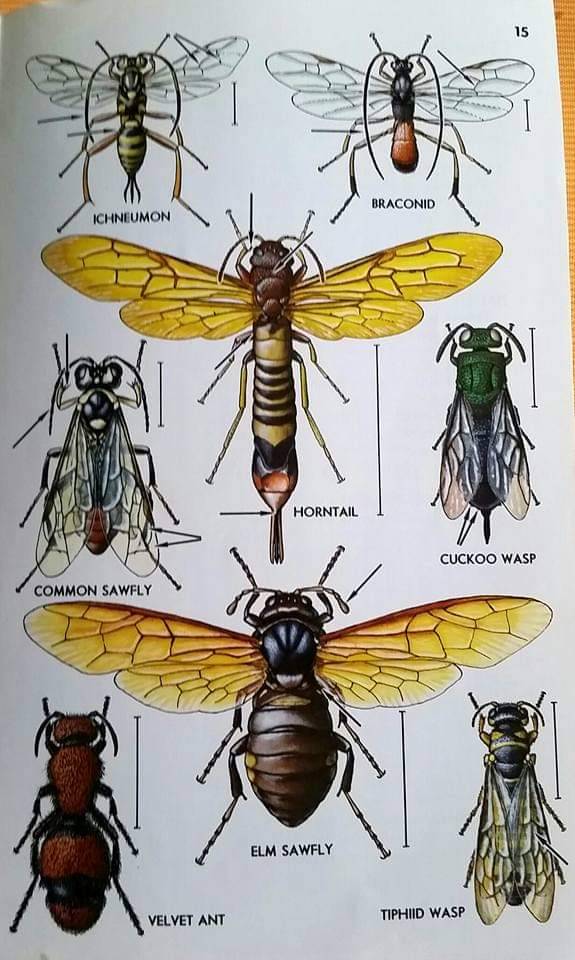
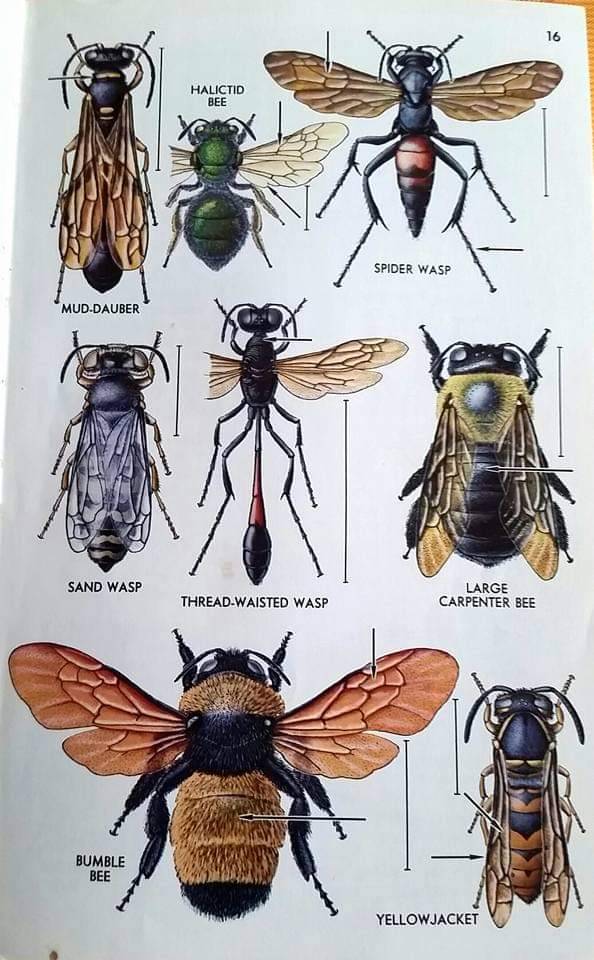
#hymenoptera#insect#wasp#wasps#entomology#vespidae#vespoidea#apocrita#aculeata#chalcidoidea#symphyta
161 notes
·
View notes
Text
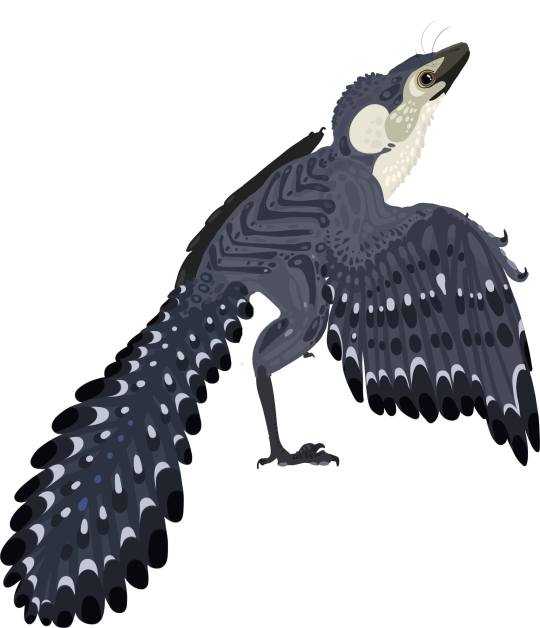
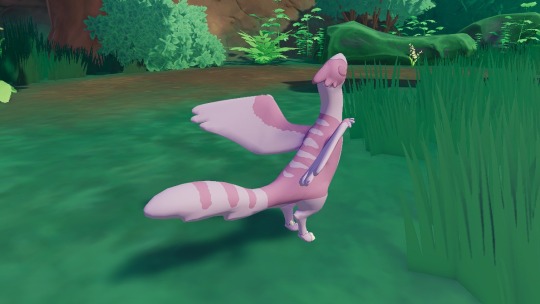
[ALT TEXT: Two Archaeopteryx . On the left, a drawing by a palaeontologist- black and white, feathered. On the right, an image of a 3D Archaeopteryx in the game Paleo Pines- both wings outstretched, eyes closed, looking up. This Archaeopteryx is bright pinks and lilacs.]
Our resident Paleontologist, Natalia Jagielska is back to give us a rating on how accurate our little Archaeopteryx is and throw some dino truths our way.
The Bare Bone Basics:
The fossil celebrity! Found in Germanic limestones in 1860s (almost 200 years ago!), it paved our way in understanding dinosaur evolution and the onset of avian flight. This feathered animal lived around warm, shallow lagoons in Jurassic Germany. Its fossils were preserved alongside hundreds of crustaceans, fishes, pterosaurs and occasional dinosaurs.
An Interesting Story:
Only a handful of variably preserved Archaeopteryx fossils have been studied (one for a time was mistakenly identified as a pterosaur!), but there are also individual feathers preserved. In fact, the first fossil of Archaeopteryx to be preserved as a single, lonely feather! The feathers, more recently, were studied for geochemical markers (using lasers, synchrotron x-rays) and special microscopy to see traces of structural pigment, melanin. Pointing to the animal having white feathers with black tips.
The Known Unknowns:
We don't know much about the evolution of flight in other flying vertebrates, pterosaurs and bats, as their flightless ancestors rarely preserve well. Birds, however, from Late Jurassic onwards, left numerous "transitional" fossils showing modular evolution that eventually led to the formation of specialised feathers and wings we know today. While Archaeopteryx was one of the first, many similar "transitional" fossils have been discovered since. Looking at claw, feather and wing morphology allows us to postulate whenever Archaeopteryx was an active flier or mere glider, could it climb or perch on trees like a bird or was more inclined to live on land.
And now for the reveal on how our little guy did in game?
Archaeopteryx: 3/5
Natalia says: "No evidence, sadly, for bright blue feathers (rare as natural pigment), the jaws in real animal are much more elongate, the model is also missing the hallux bone. I love him anyway."
Wishlist Paleo Pines to rate them yourself!
57 notes
·
View notes
Text
A Dreamtime story from the Nuenonne First Nation of Bruny Island off the Southeast Coast of Tasmania (lutruwita) narrates how [...] a young pup [...] of the “Tasmanian tiger” (thylacine) [...] transformed [...] into corinna [...]. When lutruwita -- Tasmania, also known as Van Dieman’s Land -- was opened for British colonization in 1803, a medley of settlers -- from [...] fortune-seekers to species hunters -- made it to the island in the course of a few years. Travel guides and memoirs published at the time soon dubbed Tasmania the “sanatorium of India,” drawing many British colonists to the island who hoped to recuperate their health debilitated by prolonged stay in the tropics.
More significantly, it wasn’t only materials and bodies that circulated between the colonies [India and Tasmania]. But also ideas, impressions, and experiences gained in one colony made their way to the other. [...]

Settler farmers identified the thylacine as a “blood sucking vampire” [...]. [P]olitician John Lyne -- a representative of the Tasmanian rural lobby -- proclaimed, quite preposterously, that “30000 or 40000 sheep” were taken each year by the thylacine [...]. By 1830, the Van Diemen’s Land Company was already offering a reward for the killing of [...] the “hyena” i.e. the thylacine. Likewise, Mercury reported in 1882 in a piece headlined “Tiger Extermination” that landowners declared “a reward of £5 to be paid for each full-grown tiger [...] and £2 10s, for all cubs [...]." As a result, the animal [...] was extirpated by 1936. Comparison between the thylacine and the Indian tiger abounded in settler discourses [...]. This was in spite of the fact that the thylacine and the Indian tiger were two entirely different species, morphologically and ecologically. [...] Yet early settlers in Tasmania, many of whom had first landed on or had connections in British India carried the idea of the tiger as a ferocious predator [...]. [T]hese representations of the thylacine’s “nature” were based on faulty understanding of the animal perpetuated by myopic colonial science that privileged imperial economic interests above all. [...]
---
One of the major thylacine traders in Tasmania was James Harrison. Known as the “West Coast naturalist,” Harrison purchased and sold about twenty-five live animals and twenty dead specimens of thylacine. He was born in the Nowgong district of Assam in northeast India to a family of speculators en route from England. It is noteworthy that James Harrison spent his childhood in a region in India that was known for its [...] wildlife. Game hunting [...] was [...] [a] common pursuit among the Europeans in Assam [...]. Moreover, the period saw a spike in the visit of professional hunters and species collectors to the region as vast [habitat] was being stripped off to make way for tea plantations. [...]
---
William Thomas Dennison, who served as governors of Van Diemen’s Land (Tasmania) and Madras in India, described in Varieties of Vice Regal Life (1870) the tiger hunts he had organized in India. Dennison’s book reinforced the idea that the tiger is a pest, an impediment to human progress, which echoed his policies towards the thylacine during his stint as the governor of Tasmania (1847-1854). [...]
---
Likewise, Sainthill Eardley Wilmot -- the grandson of Sir John Eardley Wilmot, the lieutenant-governor of Van Diemen’s Land from 1843 to 1846 -- served as a forestry officer in British India. Sainthill was born in Hobart in 1852 and spent his early life there. In My Home In Tasmania (1852), Louisa Ann Meredith mentions the presence of an “untamed” wild thylacine in Sainthill’s grandfather Sir John Eardley Wilmot’s private menagerie in Hobart. Later Sainthill Eardley Wilmot would take a particularly hostile attitude towards the tiger and other big cat species while working as the Inspector General of Forests in British India. [...] He also wrote an it-narrative about the Indian tiger, The Life of a Tiger (1911), that predicted the tiger’s impending extinction. On multiple occasions, he has alluded to the thylacine “wreaking havoc” on flocks of sheep in Tasmania. [...]
The material circulation of the living thylacine in India is little known apart from an exhibition of two live members of the species at Madras Zoo in 1886 [...]. The narrative circulation of the animal, however, has been relatively plentiful.
---
Text by: Bikash Kumar Bhattacharya. "Constellation Spirit, Vicious Vermin, and Icon of Environmental Guilt: Affective Entanglements of the Thylacine in Tasmania and India". The Otter, Network in Canadian History and Environment (NiCHE). Emotional Ecologies series (edited Jessica M. DeWitt and Sarah E. York-Bertram). 20 July 2023. [Image and caption also published and included in Bhattacharya's article. Bold emphasis and some paragraph breaks/contractions added by me.]
38 notes
·
View notes